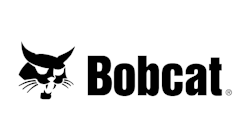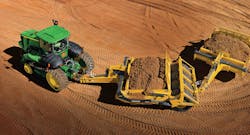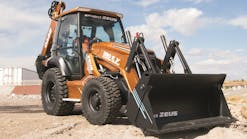Dozers are often seen in site preparation and the early stages of roadbuilding, but they may be much more versatile than you think. Other applications where dozer use is substantial include waste, forestry, fire, and disaster clean up. These niche applications put extra demands on the dozer, which manufacturers have met by customizing them into the ideal machines for these environments. Also, size matters. A lot of these markets prefer the bigger machines, but not all of them.
“Machine guarding is needed for most of these challenging applications, and in some cases protection for the operators too,” says Dave Tallon, Tractor Products Sales Engineer, Caterpillar. “Some even more unique applications are mounted plows for laying cable or drain tile, multiple spool winches for stringing power lines, moving slag in steel mills, or two-way dozers for operating inside bulk material cargo ships.”
Waste
Landfills are probably the most popular, non-traditional use of a dozer. The market is so large that most every dozer manufacturer has a set of customizations designed to optimize the dozer for landfill use.
“Dozers are popular for landfill work; pushing truck dumps, spreading and compacting trash, and building new cells,” says Tallon. “For handling waste or debris from disasters, dozers usually will get a special dozer blade, additional guarding to protect the machine, seal packages to keep waste from getting into compartments of the machine, strikers to keep material from getting picked up by the tracks, and special doors on certain compartments to make cleaning easier.”
Dozers used in landfill applications tend to be larger, and of all the dozer manufacturers, Caterpillar offers the highest horsepower waste handler dozer (436 hp) and the greatest range in horsepower (182–436 hp).
Komatsu offers three Waste Handler dozers—the D65EX/PX/WX-18, D85EX/PX-18, and D155AX-7 (the D155AX-7 is scheduled to be replaced by the -8 this summer, and will possess additional features). The dozers range from 217–354 hp. In each case, the waste handler package is integrated into the base tractor design, so it is a purpose-built machine.
For landfill applications, Komatsu dozers are modified for two primary reasons—to increase durability and improve serviceability.
“One of the biggest challenges in a landfill application is keeping the machine clean,” says Scott Ruderman, product specialist, working gear, Komatsu America Corp.
Dozers in landfill applications are equipped with components that either protect exposed components or reduce debris entry into the engine and cab. Components on Komatsu Waste Handler dozers that protect the machine from debris include deflector bars and bolt guards, a tank guard, and angled front and rear striker bars that are designed to prevent debris from riding up on the tracks and damaging the chassis. Optional track shoe holes decrease the amount of debris that piles up on the tracks.
The thermal guard covers the exhaust manifold, hot side of the turbocharger, Komatsu Diesel Particulate Filter (KDPF), and Selective Catalytic Reduction (SCR) system, reducing the potential for combustible debris to come in contact with hot surfaces. “The customizations made to a Komatsu Waste Handler dozer are designed to limit adverse impacts on the machine, including performance,” says Ruderman.
Features that minimize debris entry into the machine include a chassis seal package, engine pre-cleaner with screen, and an auto-reversing fan. “Garbage will end up inside no matter what, which is why Komatsu makes their Waste Handler dozers easier to service. An electric winch can be used to lower the belly pan for ease of cleaning. A rear mounted hydraulic oil cooler (on the D85 and D155 only) features a flexible core heat exchanger that is easily accessible for service and maintenance.
One other option (that has nothing to do with durability or serviceability) is the trash rack dozer blade. It is larger than a traditional dozer blade and has cuts in the top of the blade to allow the operator to see to the work area. “Material density in landfill applications is often lighter than dirt or rock applications, so operators can take advantage of the superior pushing power of the Komatsu dozer to increase the machine’s pushing capacity,” says Ruderman.
For the waste market, John Deere recently unveiled the 950K Waste Handler available in both standard and LGP (low ground pressure) track configurations. Four optional trash rack dozer blades are offered for the 950K in U blade, semi-U blade, and straight blade arrangements.
It too is built for durability and serviceability.
Features that improve durability include a final drive seal guarding, heavy-duty sheet metal with special perforation, uni-body track frames, a sealed electrical center, and final-drive housings with a curved shape that resists the wrapping and sawing action of debris. Cantilevered carrier rollers, recessed segmented sprockets, and trapezoidal openings in extreme-duty track shoes help prevent refuse packing. And, unlike elevated tracks, John Deere’s heavy-duty sealed and lubricated undercarriage has only one wear-causing forward-travel flex point in order to increase life.
The number of features that improve serviceability is even longer; they include a sealing package for improved debris management, an engine heat wrap, and large debris engine pre-cleaner. A greaseless center crossbar pin joint provides long life with less maintenance, and 500-hour engine oil and 2,000-hour transmission and hydraulic fluid levels increase uptime. A reversing fan inside the engine compartment can be set to change direction every 30, 60, or 90 minutes, or be activated from the seat; the variable-speed fan automatically matches speed to the demand for cool air. A unitized mainframe with flush-fit bottom guards combines with tight-fitting side shields to prevent debris from being drawn into the engine compartment.
The Waste Handler option is not limited to the 950K; any John Deere dozer from the 850K (200 hp) to the 1050K (350 hp) can be equipped with a waste-handling package.
Liebherr too offers a broad range of options and additional features for crawler dozers. Their range includes the greatest number of dozers, and the machines have a smaller horsepower (161–336 hp).
According to Liebherr, “Performance trash racks specially designed for the density and properties of the material at the landfill sites are available for the different blades. They increase blade volume and at the same time give the operator a better view of the material being transported. This guarantees high pushing performance and efficient operation.”
“Liebherr crawler dozers feature a wide array of protective guards to prevent damage to the machine caused by oversized solid waste items and reduce the amount of dust and dirt from entering the machine. This helps prolong the machine’s service life,” says Jake Gowland, district manager, Liebherr Canada.
And, similar to dozers by other manufacturers, there is also a focus on comfort and cooling. These applications can be even more stressful for the operator, so Liebherr dozer cabs are designed with the latest ergonomic aspects. As well, the engines can work extra hard in these environments and since overheating can be so damaging, Liebherr dozers are equipped with an intelligent cooling system, which enables regular self-cleaning of the radiator, along with saving fuel.
The Caterpillar D6N dozer in a traditional earthmoving application
Forestry
For the forestry industry, John Deere offers many options. “It really depends on what type of work they are doing,” says Nathan Horstman, product marketing manager, crawler dozers, John Deere Construction & Forestry. “You will see on those machines forestry screens and limb risers at a bare minimum.”
The size of the dozer really depends on the specifics of the job. Medium and large dozers are often used for land clearing or pioneering roads through the forest. “Our dozers excel in forestry applications with the exceptional controllability of the John Deere dual-path hydrostatics,” says Horstman. “With automatic load sensing, power management, and dynamic braking, whether you are grubbing stumps or working on slope, it requires less effort from the operator. To keep the thing running cool, the reversing hydraulic-powered fan (standard on 750K–1050K models) automatically back-blows the cooler cores at preset intervals to keep coolers free of debris. And with factory available limb risers, screens, brush guard, and multiple winch options, John Deere dozers are well suited for work in the forest.”
Paladin Attachments manufactures a forestry package for CASE M-Series dozers, which includes guards on all windows, an air conditioner module guard, a blade brush guard, light guards, and more.
Island Pacific Logging offers a service to convert your dozer into a remotely operated forestry dozer. It has extra guarding, a twin winch system, and all the technology needed to operate a dozer remotely.
Called ROB (remote operated bulldozer) and patented by New Zealand-based Cable Loggers, the ROB package can be installed on any North American dozer and the modified machine is designed to increase operator safety by removing the operator from the cab, access trees not able to be accessed by other machines, and decrease soil disturbance.
Dozers have a low center of gravity and the blade makes for a great anchor, so the machine has those advantages over an excavator-style forestry machine, especially when steep slope logging. A ROB dozer can operate at a slope of 45 degrees.
Since the operator is out of the cab, the machine comes equipped with more measuring and emergency shutdown tools, such as winch tension monitors, a spring-loaded fail-safe brake on each winch drum, instant shut down of the drums if a rope jumps off a winch, and an automatic machine shutdown if one of several events triggers it.
Fire
Dozer use in fire applications is not new, but it is increasing, especially in parts of the country that get a lot of wildfires. California, for example, is now considered susceptible to wildfires year-round.
Dozers used in fire applications get into some pretty difficult situations (heavy dirt, falling trees, ash, burning sap, and airborne sand). Firefighters and first responders count on the dozer to move combustible material, clear fire lines, or cut an exit path.
“Dozers can be used as the first line of defense to fight forest fires,” says Max Winemiller, product manager, CASE Construction Equipment. “In this application, it requires the machine to plow a firebreak to halt the advance of an existing forest fire. These machines operate only 150-300 hours per year but the conditions are very severe and dangerous. State Departments of Agriculture/Forestry are the only purchasers of these machines and they purchase on an annual bid basis. Because of the severity of the application and the threat to human safety, several states, notably Florida and Alabama, require successful demonstrations before they will allow a machine to be bid.”
Bulldozers are often used to reopen logging roads ahead of pumper units and for the preconstruction of firelines around heavy slash concentrations. Often working in pairs, one dozer pioneers a trail while another cleans up behind. By removing vegetation—even what is underground—the team keeps fires from spreading by leaving nothing left to burn.
“Firefighting is probably one of the most modification-intensive applications we get into,” says Tallon. “Our main priority is the protection of the operator, and then guarding the tractor to keep it functioning in highly adverse conditions. We have worked with firefighting customers and their local Cat dealers to understand their needs and develop specific firefighting attachments on our D3K2, D4K2, D5K2, and D6N. Firefighting dozers often are equipped with a rear winch, and in some regions, they will get auxiliary rear hydraulics for operating a fire plow [a plow modified for fire applications] to create firebreaks. The dozer blades usually get a taller brush guard, and in some cases, the regular blades get replaced entirely with specialized V-blades or rakes.”
Keeping the dozer operational is really important because the dozer is not only the operator’s work tool, it can be his lifeline. When fire engulfs a dozer—a “burn over,” in firefighter speak—the operator unfurls thick, reflective curtains over the dozer’s windows. This keeps the cab temperature lower (which can reach 170ºF even with an advanced air-conditioned cabin), until the operator can find a fire-free area.
“The most complicated modification is fire-resistant wrapping on all the fluid lines, electrical lines, and other heat sensitive components,” continues Tallon. “We also offer special glass in the cab and window screens for operator protection and a special cab air filter to make sure the operator has clean air to breathe. This is in addition to heavy-duty machine guarding similar to a traditional forestry application package. Beyond what we do at the factory, our dealers and customers will add additional features like two-way radios, fire suppression systems, and lighting to meet more specific needs.”
Unlike the waste industry, which prefers larger machines, dozers used in fire applications tend to be smaller. “Size is an especially important consideration in firefighting because transporting the machines to respond to a fire often needs to be done quickly,” continues Tallon. “Our D3K2/D5K2 fire dozers are popular in areas where the firefighters haul the tractors on straight trucks. In areas where they use a semi-tractor and lowboy, they will often move up to a D6K or D6N fire dozer. In the southeast US, the D6N is popular as a fire plow. On the West Coast, there are even some D8s that have been modified for firefighting.”
“John Deere’s firefighting dozers are commonly small to medium size (450K–750K) for easier navigation through the forest, but larger dozers can be used for building firebreaks as well,” says Horstman. “In firefighting applications, you see a lot of smaller dozers—in the 450 to 650 range—equipped with fire plows. They are often equipped with a V-blade or blade rake to clear debris and build a firebreak in the forest.”
Both the John Deere 450K and Caterpillar D3K2 are 80 hp. The John Deere 650K is 104 hp and the Caterpillar D6K is 160 hp.
CASE says their 92-hp 750M is the highest demand size, but the 850M and 1150M, as well as the 150-hp 1650M, are other appropriate sizes. “Size considerations are based on maneuverability, transportation and the power to uproot trees,” says Winemiller.
CASE Construction Equipment reports that common modifications include a 98-inch PAT (Power Angle Tilt) blade, LGP (low ground pressure) tracks, increased horsepower, front and rear counterweights and hooks, heavy-duty brush guard grill and radiator guard, rear disc tiller (fire plow attachment), auxiliary hydraulic connections and controls, fire sleeves, and a communications radio and fire extinguisher inside the cab.
“These modifications add a significant amount of weight, which doesn’t hurt the Dozer’s performance as much as aid in traction,” says Winemiller.
Because of the risk and complexity of working in fire applications, dozer operators working in these applications need more training than dozer operators working in traditional applications, or even than the other non-traditional applications. For those applications, regular dozer operator trainingthe combined with some site-specific training is usually enough.
There is no national standard for dozer operation in a fire application; however, operators must have some firefighting training that employs LCES (lookout, communication, escape route, and safety zone). The Florida Division of Forestry describes an experienced dozer operator: “A dozer operator with 20 years’ experience with both Federal and County fire agencies believes his most notable achievements have come when he sticks to the basics of LCES. He first anchors his dozer line before moving forward. He ensures that his lookouts, communications, escape routes and safety zones are in place. Only then can he proceed safely, continuing to update his LCES as dozer constructed fireline advances.”
It is also more crucial that the operator truly understands the dozer, and is adept at diagnosing and fixing problems with the machine in the field since, if the dozer breaks down in the middle of a forest fire, the operator can’t expect a lowboy trailer to come pick him up.
The Caterpillar D6N dozer in a traditional
earthmoving application
Ice
Sometimes dozer special feature packages don’t serve an application, but an environmental condition, such as extreme cold.
Dressta makes such a package. Their Arctic Package Special Feature Request (SFR) is commonly solicited by companies operating in coal, oil, and gas applications. Many of these projects are located within the Arctic Circle in sub-zero conditions as low as -60°F. The Arctic Package SFR fully equips any Dressta machine to retain optimal performance in these challenging climatic conditions.
Most of the features of the Arctic Package SFR are heat-related. These include engine pre-heating; a fuel heating system; heaters for the hydraulic and engine oils, the engine coolant, and battery box; and cab heating. The cab interior and battery box are heated using an Airtronic air heater that is installed below the cab platform. The Arctic Cab includes double glazed windows, outer thermal protection of the engine compartment, tight side sheets, and a regulated radiator louver.
Other key features include additional lights that are fixed onto the blade lift cylinders for good visibility during blizzards and working at night, steering levers instead of steering joysticks for better control when wearing heavy gloves, and reinforced components (blades, push arms, and ripper shanks) for better resistance to extreme abrasive materials, such as chromium ore and nickel ore.
Coal
Dressta crawlers spread their weight across a sturdy undercarriage for great balance and stability, making them proficient on the slopes of coal piles. With the compaction equipment installed, Dressta dozers can operate on lengthwise slopes of 25 degrees and crosswise slopes of 20 degrees.
To optimize dozer performance on the slopes, Dressta dozers can be equipped with the Stockpile Compaction Equipment Special Feature Request (SFR), featuring a steel and winch line attachment. The company describes the system: “Brackets attach the drum to a winch line that is fitted with a tensioning system to prevent the line contacting the slope face at any time. It is also equipped with a system to ensure precision line guidance, as well as a cleaning system to remove coal contamination from the components.”
A specialty blade is often used in these applications. Both Dymax and Rockland Manufacturing manufacture a dozer blade for coal.
Dymax Coal Blades has been manufacturing oversized coal blades since the ’60s; the blades feature a specially designed moldboard for excellent rolling action and an increased blade capacity of more than 200% when compared to standard dozer blades.
The Rockland LM Coal U-Blade features length, height, and wing angles developed specifically for high-production coal dozing. As well, extended end plates help contain coal loads and eliminate side spillage, and carbide-embedded hardfacing is available on the outside end plates.
Disaster
Dozers are used in disaster clean up, whether the disaster is natural (flood, hurricane, or fire) or man-made (train derailment or bridge collapse).
“Hurricanes can severely damage beaches as they come ashore, and our dozers are one of the primary tools used in beach restoration,” says Tallon. “These tractors are usually equipped with wide, low-ground-pressure tracks, and sometimes special seal and corrosion resistance packages for operating in saltwater.”
Hulcher Services Inc. has a lot of experience cleaning up after disasters. They cite their Caterpillar dozers as some of the most versatile pieces of equipment in their fleet. Their dozers, which range from 100–220 hp, are equipped with a six-way blade for grading or clearing the site and a rear-mounted winch. The company considers their dozers ideal for the following tasks:
- loading, unloading, and installing track panel
- installing diamonds, retarders, and switches
- performing grade stabilization
- trenching, culvert, or ditch work
- demolition of structures
- environmental remediation work
When not on the front lines of disaster clean up, dozers play an even greater role in managing all the waste. “Debris from disasters usually finds its way to landfills, and our dozers play a key role there, with special packages designed for that application,” says Tallon. “We definitely experienced an increased need for landfill dozers after the Texas and Florida hurricanes last year.”
There is a lot of crossover of equipment and technology solutions between applications. Components such as guarding and better cooling technology are almost universal. The larger blades that are used in waste are also often used for woodchip stockpiling in forestry. The same types of attachments needed for beach reclamation are also used in dredging to maintain rivers and waterways. Some fire tractor dozers feature a full forestry cab kit. And, some fire dozer guarding attachments are leveraged from a company’s attachments forestry applications.













